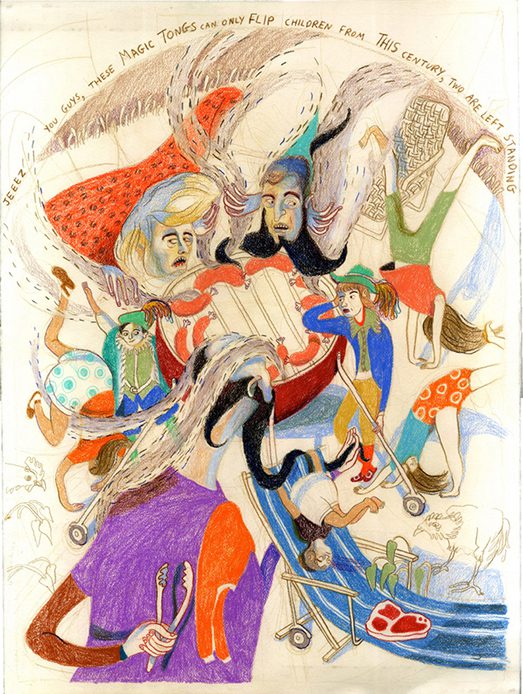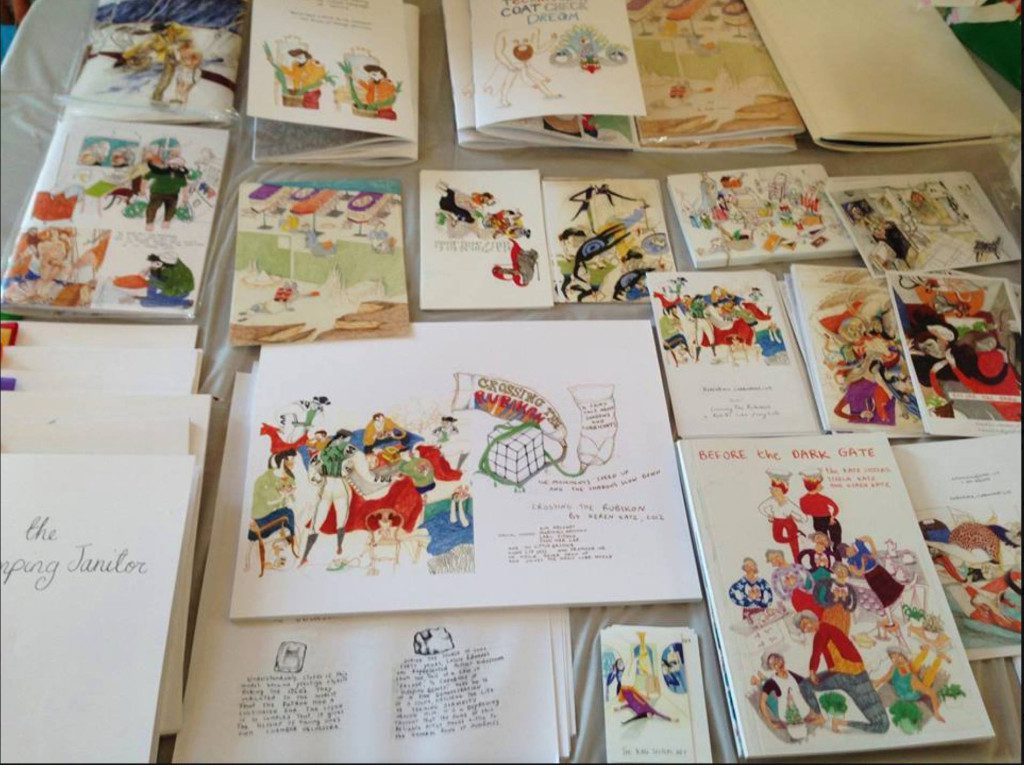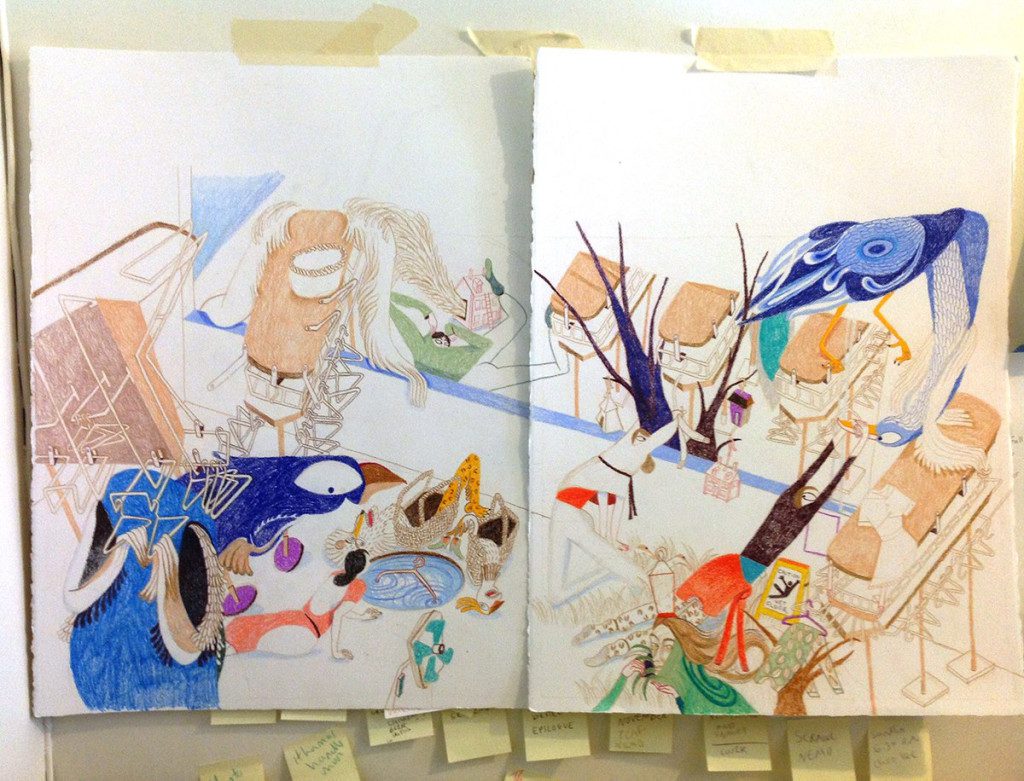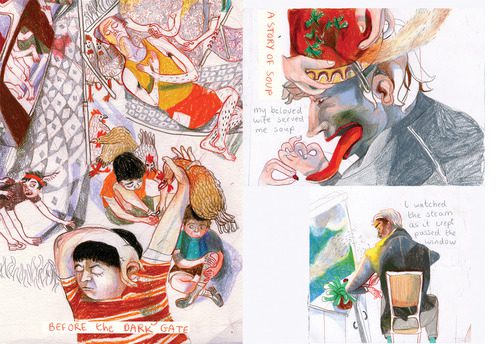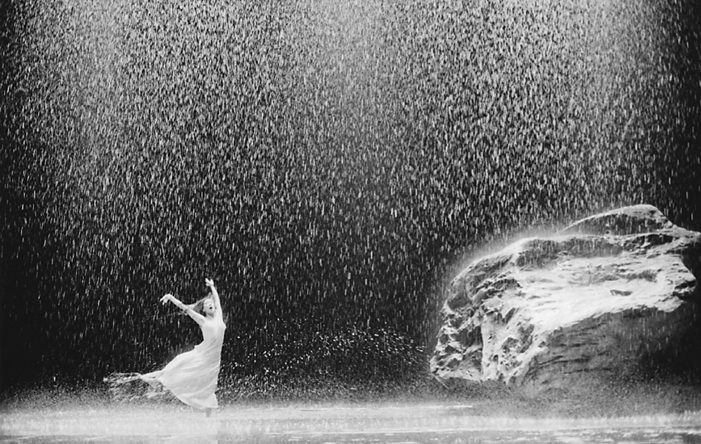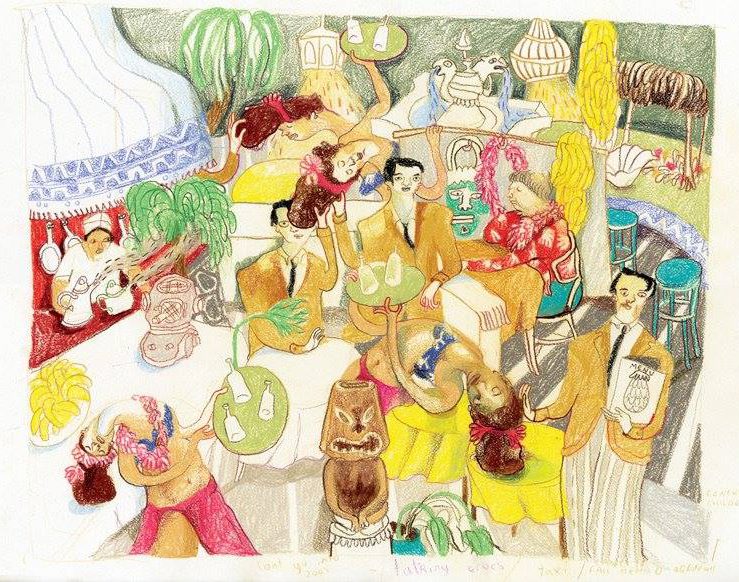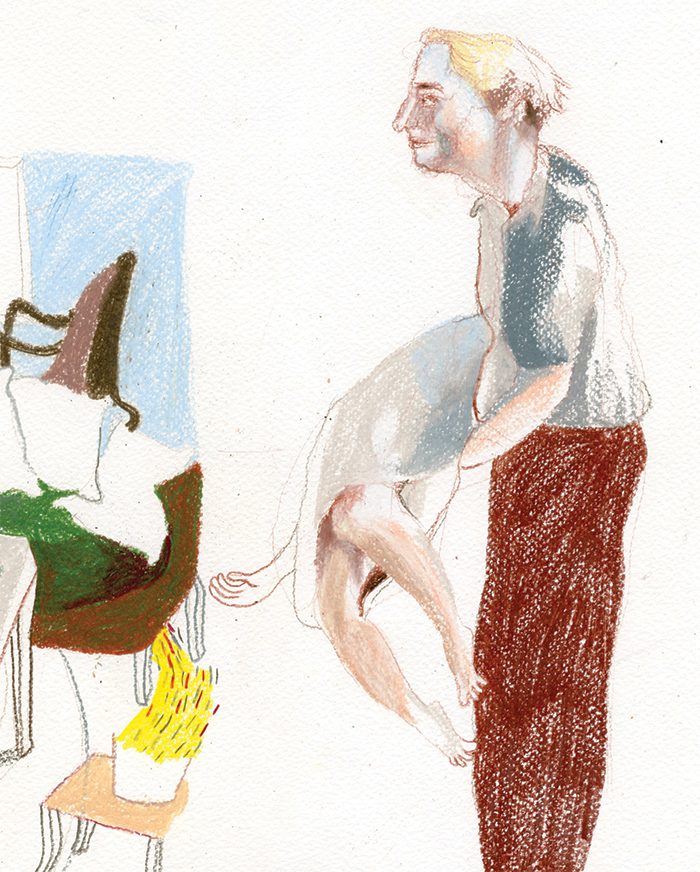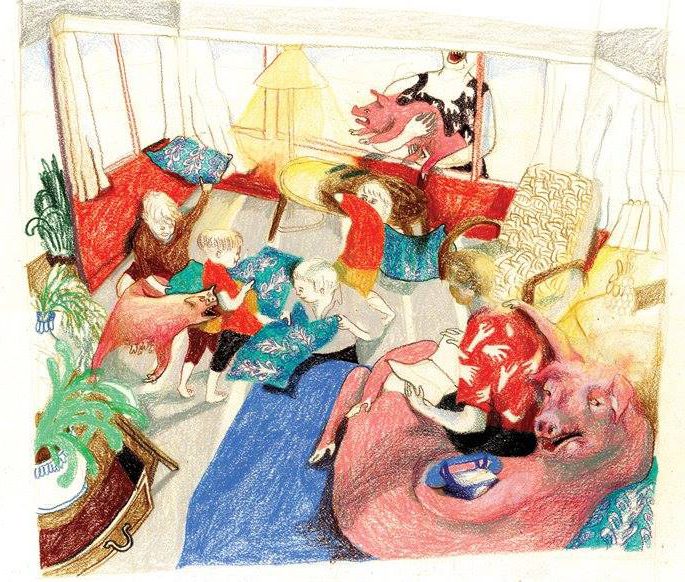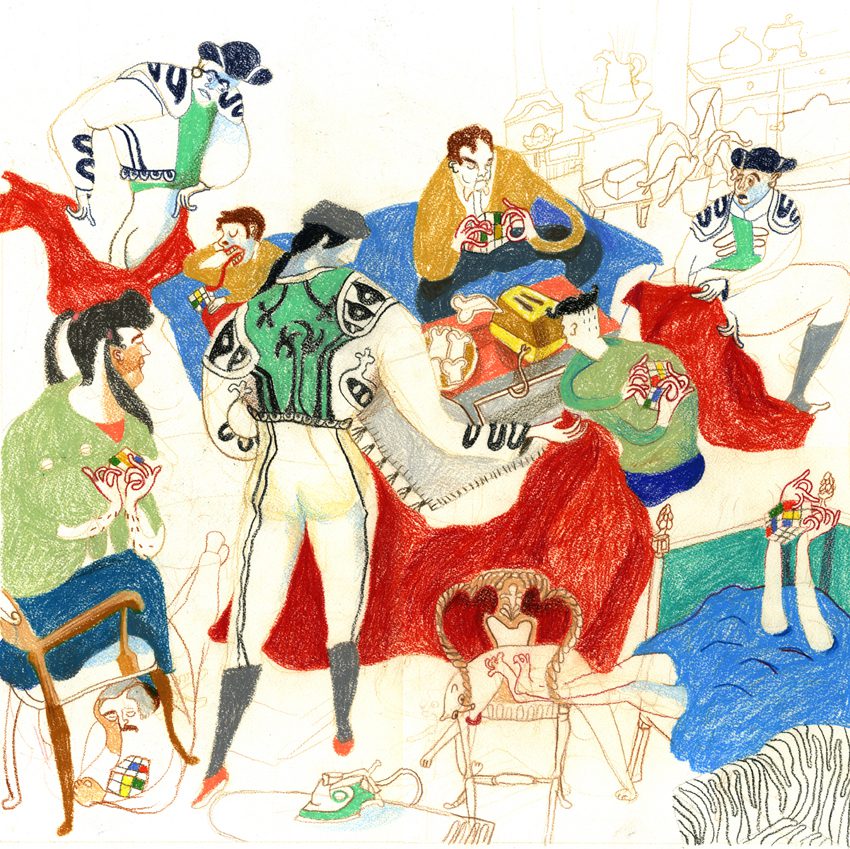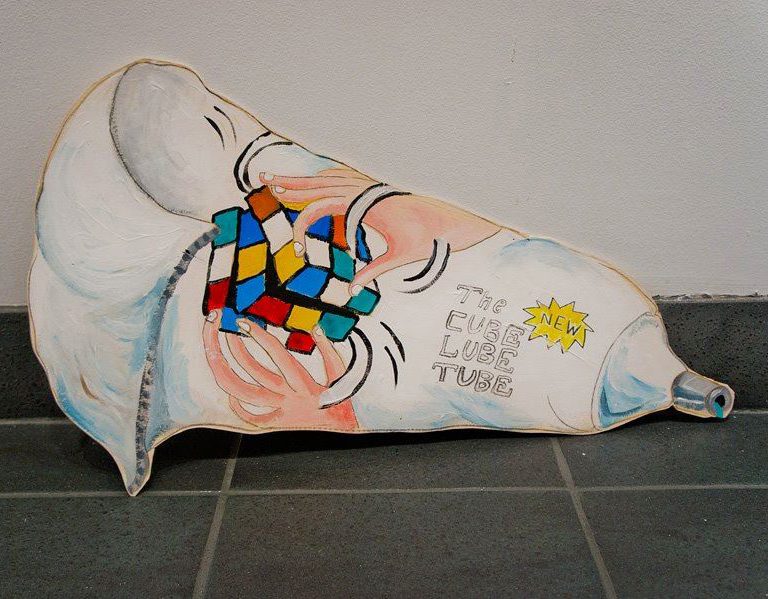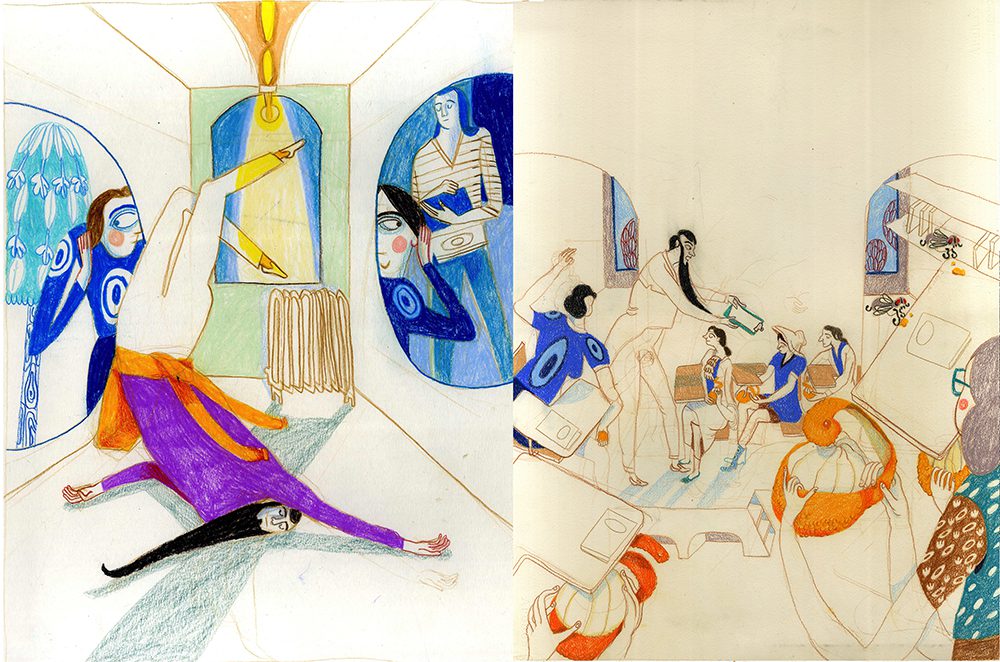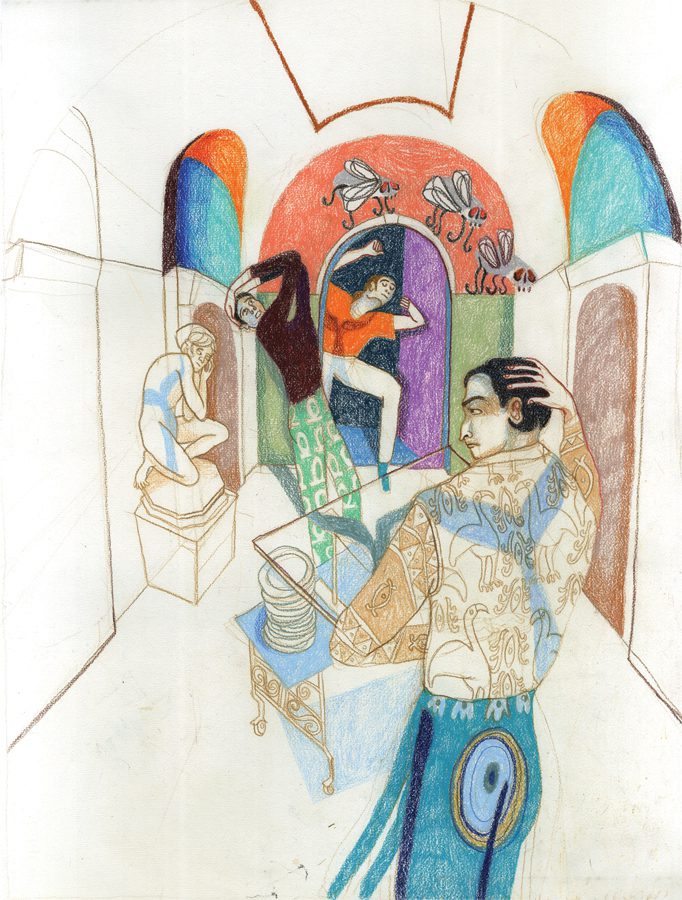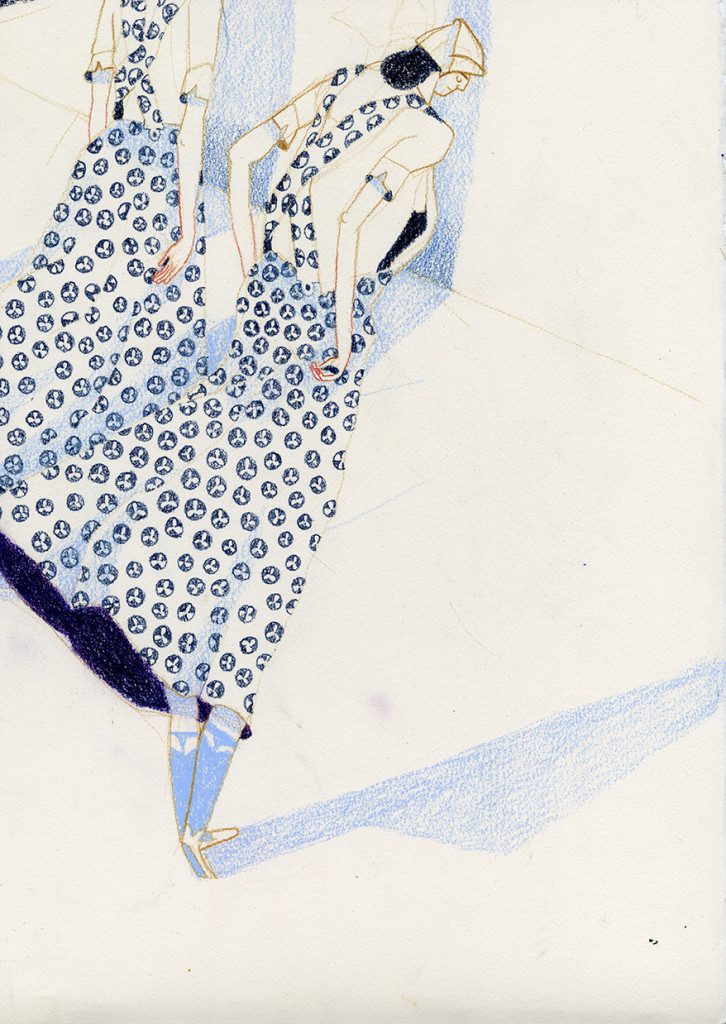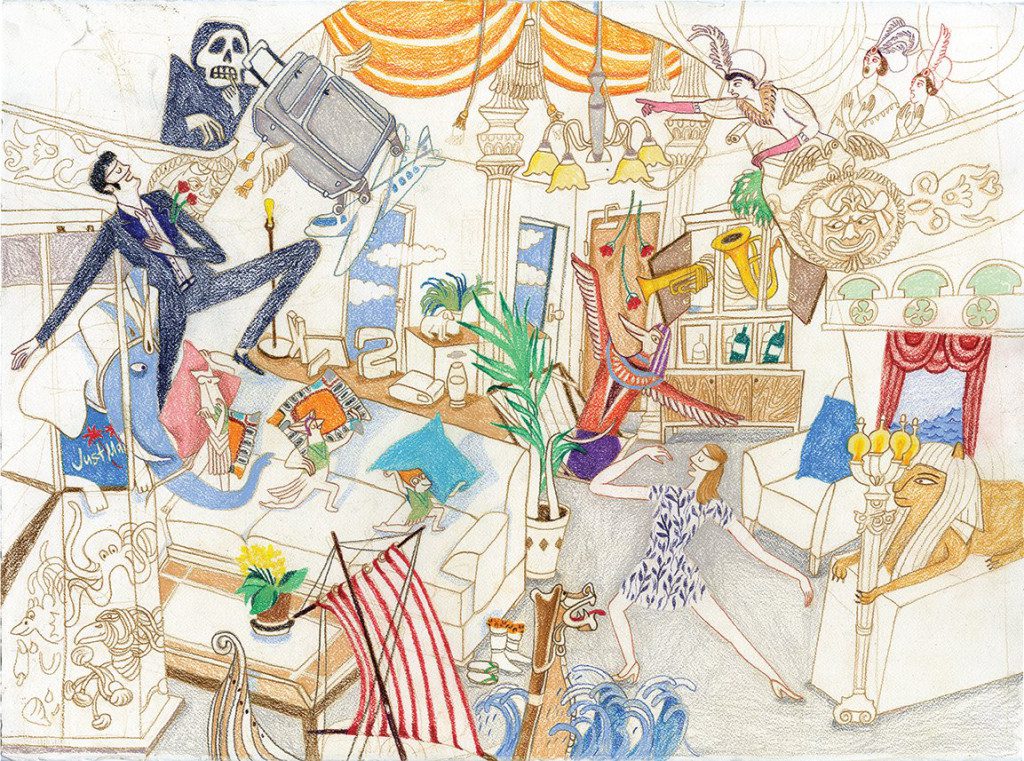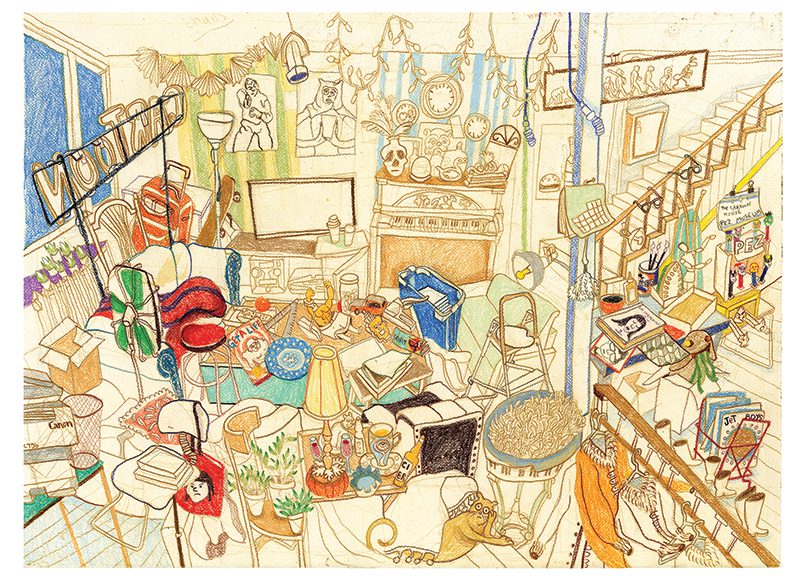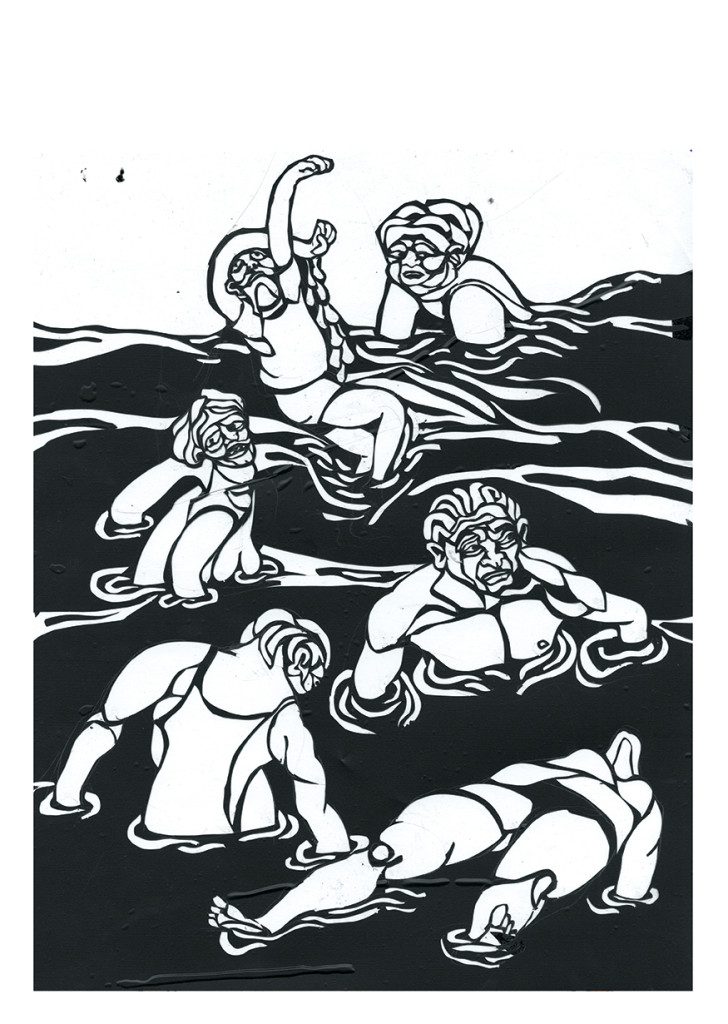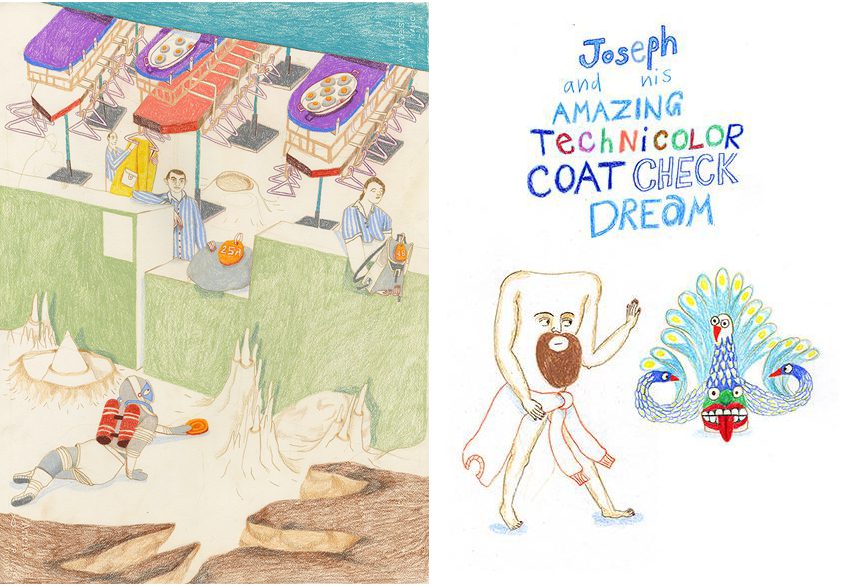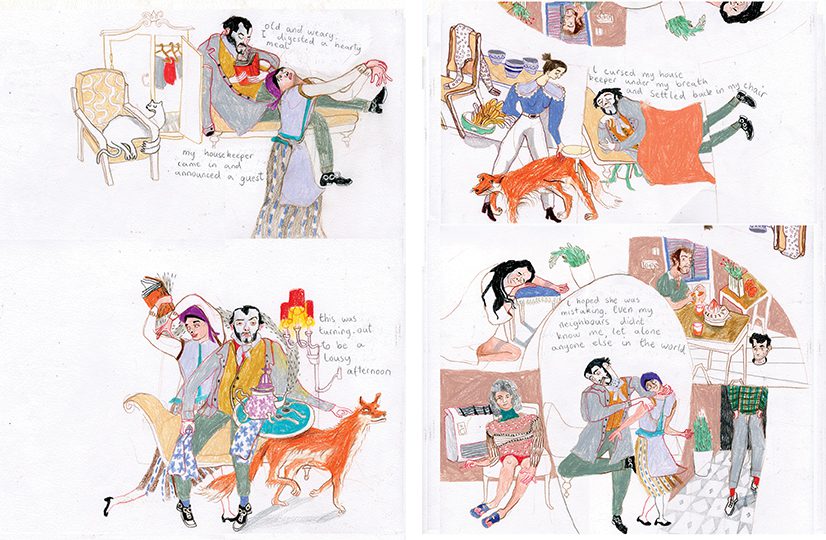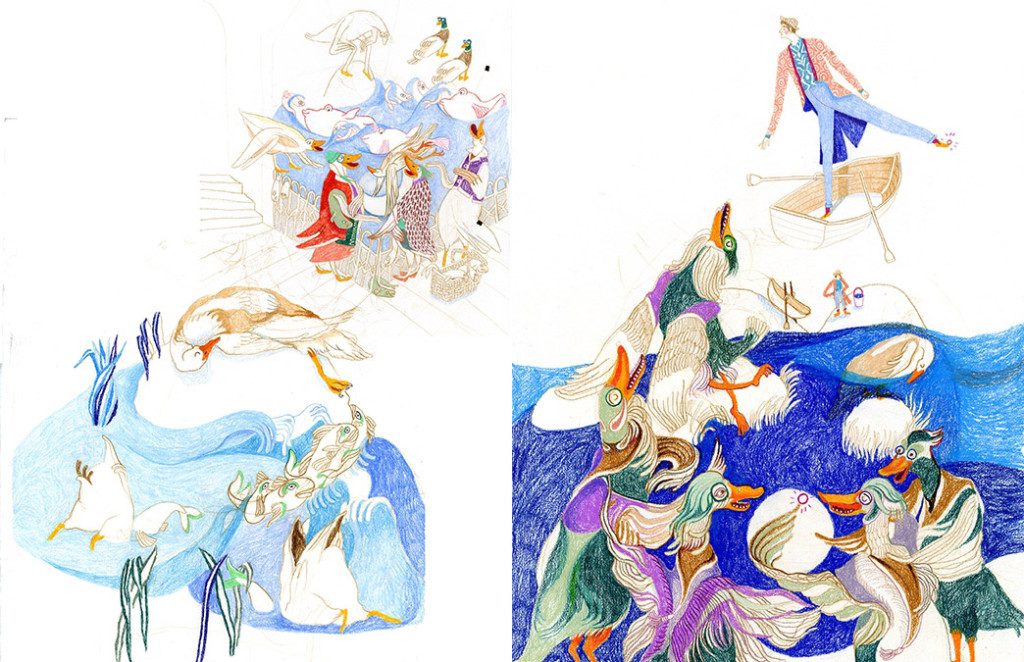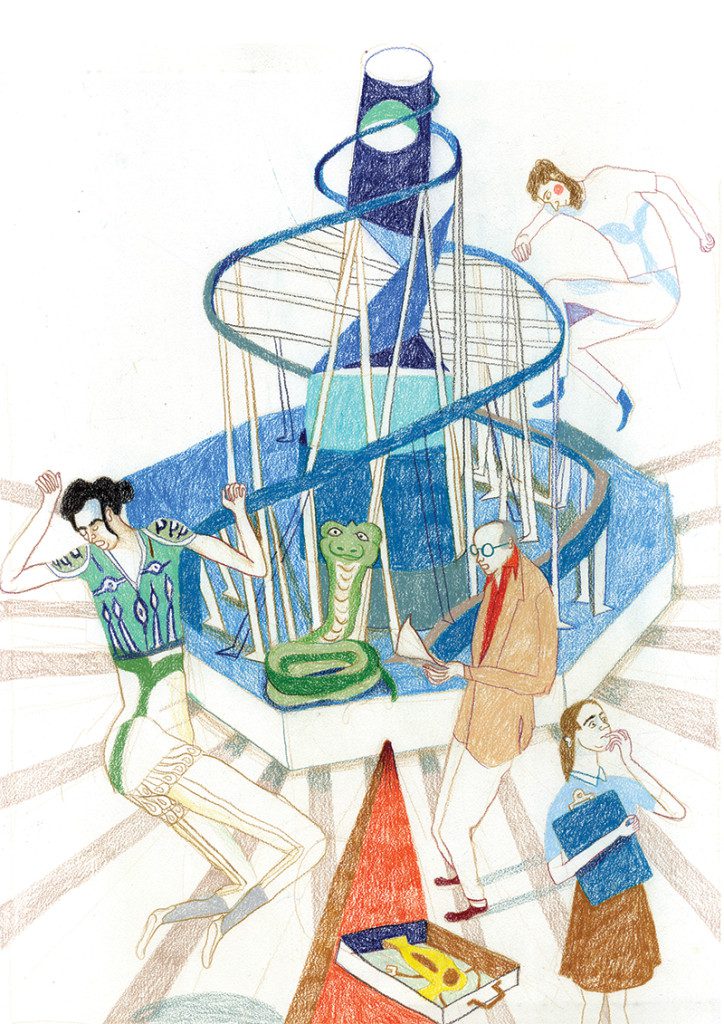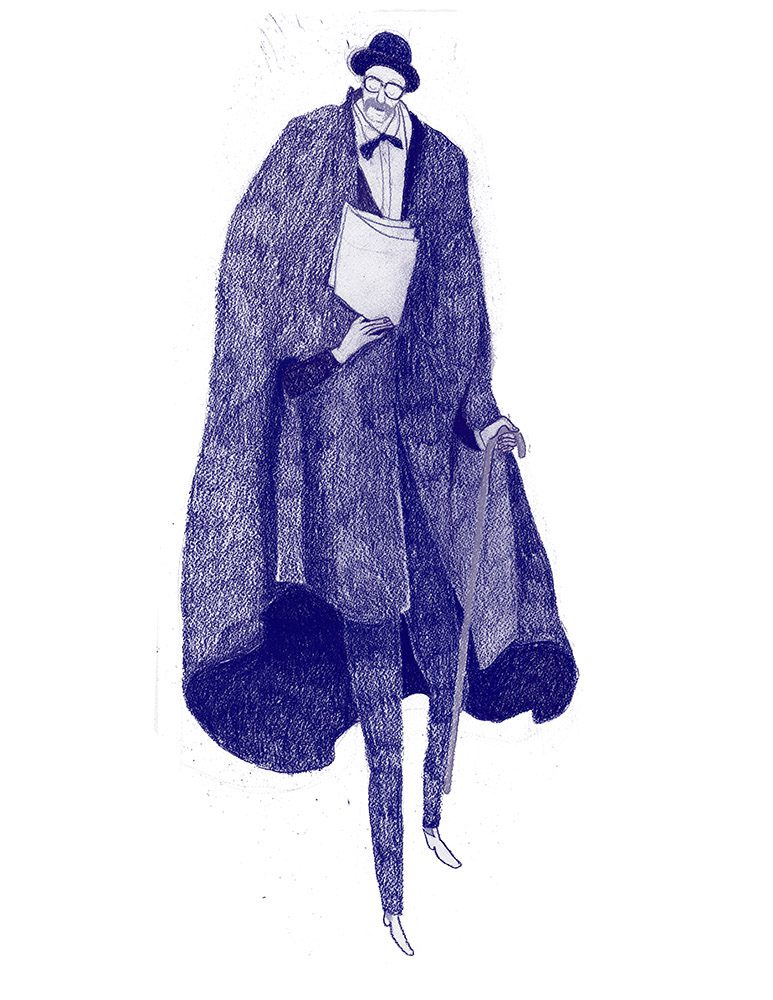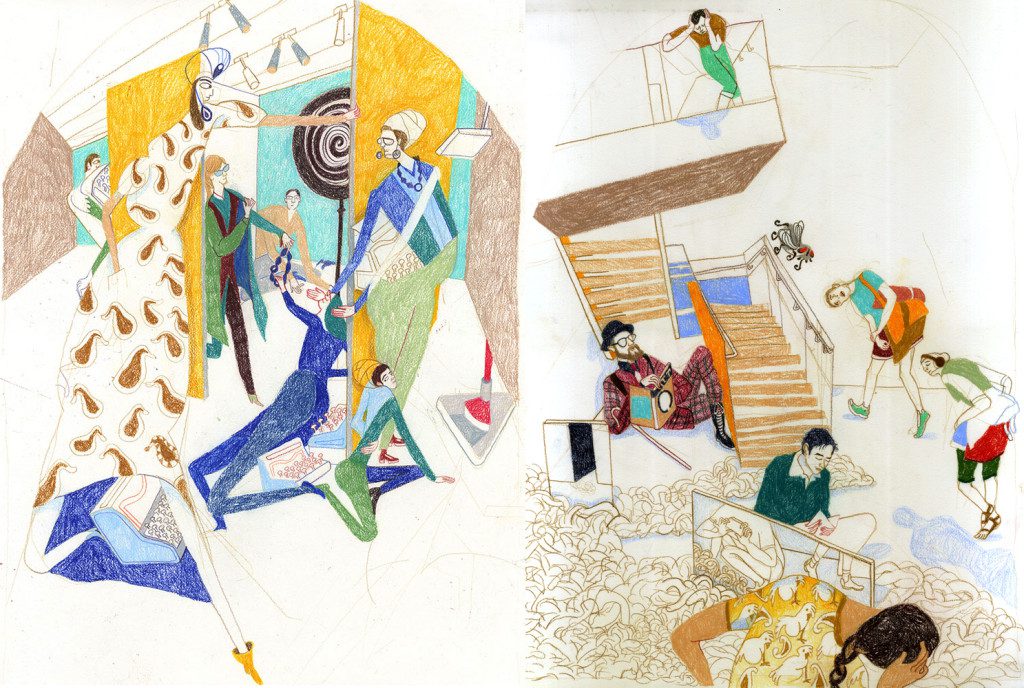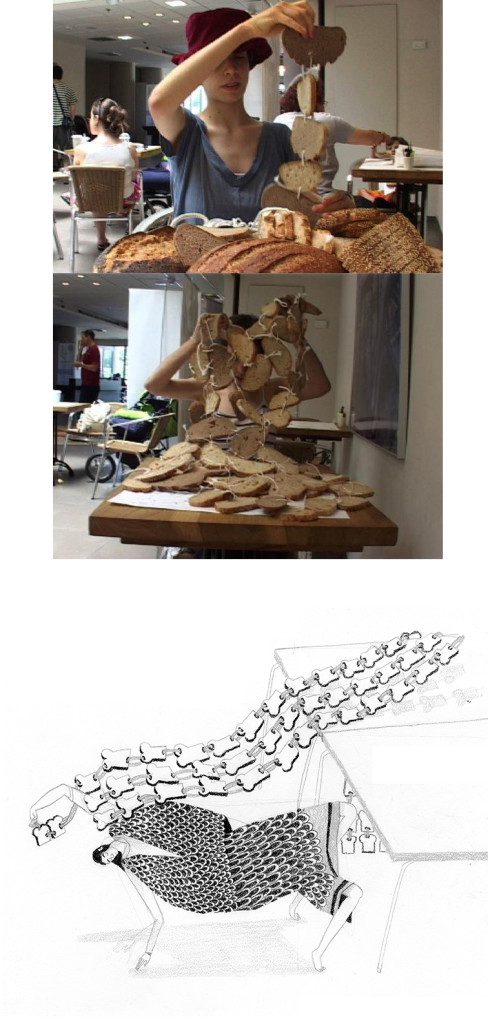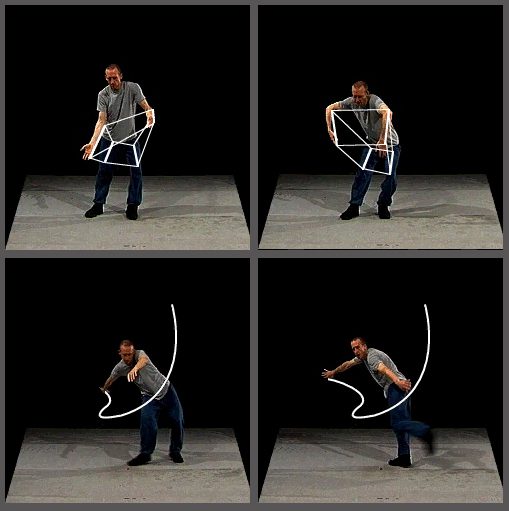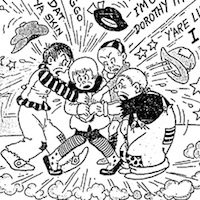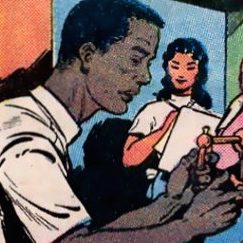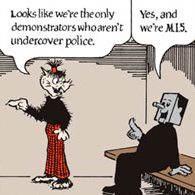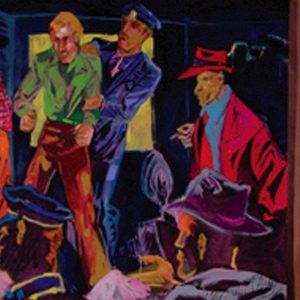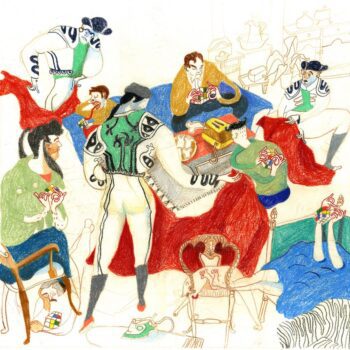
The New York Comics & Picture-Story Symposium is a weekly forum for discussing the tradition and future of text/image work. Open to the public, it meets Tuesday nights from 7 to 9 PM EST in New York City. Presentations vary weekly and include everything from historical topics and technical demonstrations to creators presenting their work. Check out upcoming meetings here.
Keren Katz is an Israeli-born cartoonist, writer, and illustrator. A recent graduate of the School of Visual Arts’s MFA Illustration Program, she is also “the illustrating half of The Katz Sisters duo. She is also the half that is not fictitious.” Her self-published books include The Night Poetry Class in Room 1001, Chronicles of the Falling Women, Joseph & His Amazing Technicolor Coat Check Dream, Crossing the Rubikon, Before the Dark Gate, and William Barnacle. Her work has been published in The New York Times, The Brooklyn Rail, Einayim Magazine for Children, Achbar Ha-Ir, Ha-Af, Ha-Pinkas, Carrier Pigeon, Linen Ovens Comics Poetry Anthology, Maayan Poetry Magazine, and by Locust Moon Comics and Seven Stories Press. Her book, Uncontested Spaces, will be published by NO Press, and several of her comics are distributed by Domino Books.
The Rumpus: Your path to comics and illustration took you through a number of different fields: science, ballet, the army, illustrating photos by your roommate, etc. Can you talk about how you became interested and how you became involved in comics?
Katz: When I quit ballet, I felt desperately invisible which led me to art school. Losing dancing as a language had been very traumatic for me not only as a creative outlet. I have a tendency to be extreme when I communicate and I’m always trying to balance between hyper-talkative states and silences. In dance, A Stillness can be performed in an intensity that is communicative. My solution is to have objects on hand to thrust at people in place of my stillness. These buy me more time to think of fully formed stories because I don’t trust myself with a moderately paced stream of words. In a way this is my form of comics, I alternate between words and objects, I advance through conversations in still frames. It’s very hard for me to create the in-betweens. The need to perform has been displaced into my verbal language. I love reading comics because I’m moved by how different artists activate the spaces in between the frames.
The Rumpus: What types of stories and images do you find compelling?
Katz: In my masters program at The School of Visual Arts we had a class called Drawing On Location. Our teacher, Carol Fabricatore, would take us to different locations in New York. We would split up with our sketchbooks and regroup after 3 hours to share the story of our mini adventures. In the beginning of the year when we were still getting to know each other and the city, I felt overwhelmed. I didn’t know what to draw, how to frame things. From week to week, we learned about each other through those stories, but it also helped me learn more about the things I wanted to draw or repeat. I was eager for specific people to see them. Carol would always encourage us to change our drawing tools, change drawing hands, or even to draw with both of them simultaneously, to talk to our subjects, to write down when the words that are more important than what we see and visa versa. I think that is the kind of “comics” I’m doing. It’s not sequential, it’s recording the dynamics of a scene with as many tools as possible. I want to capture all the words and all the colors and all the motion that belong in a space, and then I move on. It may be redundant, but it has a rhythm that I enjoy.
When I work on a new story I have in mind the people I will send it to. Even comics I created as part of a school assignment served primarily as a love letter for someone I wanted to talk to.
The Rumpus: Can you describe some of your influences? And how you work with reference?
Katz: I need a constellation of images to keep me company while I draw and to help me hold on to a shape, but it doesn’t even have to be the same ones which started me off on a particular idea. When I get inspired by something, it is usually an abstract feeling which I need to constantly zap back into my head.
The next frame is inspired by the shapes and the colors in the previous frames in conjunction with the reference. It is not a continuation of their content necessarily. Even if I have a full story to begin with, I will reinvent a second story according to what I have already drawn. I work on large pieces of paper so I can move in any direction I want. Each of my books turns out more like day dreaming out loud but I strive to improve on this and make these internal sequences more communicative.
What I like about being part of a comics community, is that I always get a chance to meet the people I give my books to in person. I may be using this as an excuse to allow myself this freedom of improvisation. Theres a sincerity to improvised dancing ;I can trust my body to ground and authenticate my internal logic to fit the structure of it’s joints into something very direct.
I think that’s what I’m drawn to in comics; interchanging its two basic elements, text and image, to transmit a rhythm which is seen no matter what my subject is. There’s an intimacy to the way the words are inserted and the images are placed side by side, bound and folded. It pinpoints exactly where I get stuck, where I stutter, how I move. I still don’t feel I’ve reached a point in my storytelling that is as honest and transparent without me standing and talking about it over my table at a comics festival but I’m nonetheless enjoying the process of learning.
The Rumpus: Do dance and performance inform your work at all? How?
Katz: I’m inspired by choreographers and especially by Pina Bausch and the way she sets a stage for a story. In her piece Café Muller, the dancers move through a stage full of chairs. They fall, crash and spin blindly amongst them. Sometimes they dance in each other’s arms, but other times, they encounter their fellow dancers indirectly only by crashing into a chair, which another dancer has pushed over. I see it as dancing with each other’s falls. Falling is such a lonely movement. It is so hard to echo and it’s never long enough to be mutual. Another example is a piece where Bausch placed a giant rock on stage. When someone dances next to it, it echoes movements in him or her that can’t be echoed directly by a fellow dancer. It echoes a roundness, a roughness, an inhuman silence. If instead, a second dancer was curled up in a silent ball, I would be concentrating on whether or not he is more beautiful than the other dancer. There’s an inherit competitiveness to human interaction which still objects don’t have. They can also highlight hidden movements, like a giant red ball on stage that lights up the curved lips of a dancer and their breaths can be seen all the way to the very last row. Maybe I’m misinterpreting this but this always brings me to tears.
In my own work I use surreal juxtapositions which always interfere with my narrative, I would always prefer adding red to my drawing by extruding a character’s tongue out, even if it makes no sense in the story because I want to place emphasis on a red chair in the background.
Rumpus: Tell me about Chronicles of the Falling Women.
Katz: Chronicles of the Falling Women is the telling of 40 symptomatic events in a time of a mysterious epidemic causing only women to constantly fall down.
All my stories are about movements. Falling is the ultimate one for me. It can be tragic and funny and dramatic and romantic but it’s always lonely.
Intentional falling is on the verge between dancing and being “real”. What inspired me most to do chronicles of the falling women are the characters echoing each other’s falls in Pina Buashe’s Café Muller and especially a scene where two dancers crash into each other’s arms and fall apart 50 something times. But while it’s a performance, they also endure a “real” pain of the fall. The women in my book suffer from falling episodes so frequently and magically that they are almost flying and no one can hold on to them.
I’m still looking for a way to articulate this fascination, which is why I continue to make books about falling. I need to explain it to myself.
In my book Joseph and his amazing Technicolor Coat Check Dream, the protagonist talks about his two mentors: the one who falls, the artist Bas Jan Ader who tragically disappeared, and the one who flies, the great Olympic sky jumper, Walter Steiner. The latter had a need to disappear and fly off so he developed a crazy inhuman talent for it. However, he reached the tragic point of being so good at jumping/flying that he could no longer fit in any sport arena because no one could predict where he would land. He was eventually banned from jumping off the standard ramp, He would still win and jump really far, but he couldn’t fly because it was too dangerous.
The Rumpus: Tell me about Crossing the Rubikon.
Katz: Crossing The Rubikon is a mash-up fairy tale between the world of Neverland and the world of speed cubing. Captain Hook is a former Rubik’s Cube champion but when his hand is bitten off by a crocodile, he chases down the lost boys and the speed cubing prodigy Wendy in order to cut off their hands and restore his days of glory. I was inspired by an 80’s magazine advertisement for cube lube and my jealousy of my little brother’ s success at solving it. I became addicted to Youtube tutorials and the enormous speed of the fingers devouring the surfaces like hungry crustaceans. Ultimately, in all my books I’m inspired by movement. Each scene in the book is centered on the incessant twiddling of thumbs and pinkies and the dangers of becoming obsessed. I said before, I have a specific fantasy audience in mind when I draw. In this case it was Michel Gondry. He made a great video of himself solving a tiny Rubik’s Cube with his nose. I fantasize about mailing him my book.
The Rumpus: Can you tell me about your MFA thesis project with Maira Kalman: The Night Poetry Class in Room 1001?
Katz: The Night Poetry Class is a collection of ten short stories Scheherazade tells a boy she likes on their way to a poetry class in the hopes of him falling in love with her before their arrival. The more stories she tells him, the further away the room moves from them.
It’s basically the story of my very bad first date with my boyfriend. He asked if he could walk me home. I was so anxious to talk to him and win him over that I told him I lived in a house that was really far away so we could walk all night. My plan worked perfectly only to the point where he waited for me to enter “my” house. I dove in the bushes nearby pretending to look for a key I dropped hoping he would go away…
It meant a lot to have someone I look up to as an audience. Maira encouraged me to be more direct in my writing. To clean it completely from the images I usually hide my words with, and only then begin to draw. I was afraid to leave the story alone on the page by itself. I’m also afraid sometimes of leaving an image alone by itself without words.
The Rumpus: Your newest project, Were You Watching?, for Locust Moon Press’s Quarter Moon anthology, is a beautiful short story about romance and longing. Tell me about it.
Katz: Were You Watching was created for the Erotica issue of Quarter Moon. This is my first attempt at writing something directly autobiographical and expressing my desire to perform as I mentioned earlier.
It’s a comic where each page represents a single moment in a year of my life from ages 13-25 in which I desired desperately to be seen. However, I was never alone in those moments and in most of them, I was actually with a boy I liked, but I also wanted them all to be connected by a single thread, by the eyes of one person, as if they were making a movie of my life. Whenever I meet someone new, I feel compelled to tell them every single detail about me and give them every single book I ever made. (This is why I will never make money from comics!)
The Rumpus: You explore and animate spaces and inanimate objects in a way that’s unique and almost magical. Can you talk about your room portraits?
Katz: I was encouraged to do these by my teacher in undergrad in Bezalel. I was struggling to design characters to convey a very emotion heavy script and upon looking at a drawing of my room I made, he told me I should draw people like I draw furniture. This remark was the main catalyst for the way I have been developing my style. I think it’s easier for me to make up stories about furniture than people. It’s easier for me to toss them into my own world and impose my own memories on them. I enjoy the constraint of creating a movement in a still composition. They are also something I spend more time looking at. Most of the conversations I have, I’m staring at furniture instead of looking directly at people’s eyes, so the human voices might as well belong to them.
The Rumpus: You seem to primarily work in colored pencil, but your cut-outs are another major part of your work. Can you talk about how you learned this technique and how you use it?
Katz: The cut-out technique is something I learned in my first year of undergrad in Bezalel. The entire first semester is dedicated to black and white techniques. It gives a result similar to a wood cut. I stick black shelving paper on a plastic sheet and then peel off with an X-Acto blade. When I work like this, I follow the same constraint I give myself in my color technique. Every shape I peel off informs the next one and I let my mistakes and serendipities create the narrative.
The Rumpus: In your first Symposium presentation, you discussed how political messages are very complicated in Israeli comics. Does this affect your work at all?
Katz: I have had a few opportunities to talk about contemporary Israeli cartoonists and I can’t avoid the political context, but I am not a political person to say the least. I always feel guilty about it as though I’m ignoring a responsibility that is fundamental to the medium and to the practice of art in general. That is identifying oneself with a point of view. I do have one, but I am terrified to explore and express it, so I shy away from it completely. This is another reason for my improvisational fragmented storytelling style and my search for random references and scraps of text. My characters are always as far away from myself as possible; matadors, pirates, foxes, ducks, fire places, bearded mesmeric professors, jumping janitors with no necks and no coat racks. I heard one of my mentors in an interview a few months back saying that she is drawn to great stories which may have the added value of political resonance due to her specific Israeli circumstance but they don’t start off as being political. The danger of choosing to make political art is that it comes out one-dimensional and will always conceal the other side. A good story needs characters that are round. Israel has a culture that is obsessed with institutional storytelling and enforcing the collective memory of its survival because its existence is justified by those stories. Comics as a hybrid medium are so well suited to articulate tension and to contest the institutional narratives with the stories which get lost in the margins. But the way I use it and the way I juxtapose words and images isn’t to illustrate tension, but more as mnemonic devices to map a stream of associations.
The Rumpus: You’re going to be part of the children’s book anthology, The Graphic Canon of Children’s Literature (Seven Stories Press) coming out this summer. Are you interested in children’s books? Can you talk about your piece
Katz: I’m very drawn to fragmented and fractured text, which demands a lot from the imagination to complete it, or on the flip side to extremely dense pieces of writing which need to be aired out. Kafka’s Blue Octavo Notebooks inspired one of the first strips I ever made. I used my images to interpret the text for myself because I couldn’t extract any meaning from it without drawing it out.
For this project I chose from the latter category. I chose five Hindu Fables by Tolstoy about the dramatic and deathly consequences of being a bird in general and being excluded from a group in particular. The stories are no longer than 2-3 sentences each and death takes up a large percentage of the words which constitute them. My challenge was to expand the horizons of the world the birds lived in and give them enough movement to balance out the tragedy of their inevitable demise.
The Rumpus: How did Uncontested Spaces come about? What was it like making it?
Katz: Uncontested Spaces was the title of a series of guerilla poetry readings in the MoMA galleries hosted by the MoMA poet laureate Kenneth Goldsmith. An insane amount of poets flooded the MoMA over the course of almost a year, their voices twisting and contorting the gallery spaces, redefining what is abstract and what is figurative in the galleries and challenging the narratives of the museum with their own.
I attended those readings weekly armed with my sketchbook and arsenal of pencils behind my ears and recorded as much as I could, constantly changing between jotting combinations of words I fell in love with and drawing the dynamic gestures of the poets hacking away at the monotonous rhythms of the paintings. I was being watched too. I intentionally wrote down certain down words for people I felt looking over my shoulder, or drew with large gestural movements to lure someone from across the room. The series of the transformed gallery portraits will be published by No Press.
For many years now, even before art school, I was given odd assignments by a poet named Roy Chicky Arad who is also one of the founders of a movement called Culture Guerilla, demonstrating for social and political rights with poetry. His continuous use of the phrase “important official drawing assignment” caught on to me although it had no meaning and consequence whatsoever. It only resonated a compulsion I have to record something for someone in order to make me feel like I am standing in the right place, like I belong. He is the default audience of anything I am compelled to draw. In this particular book though, I was on a mission on behalf of my boyfriend who lives in Tel Aviv and is also a guerilla poet who I met while on a drawing mission. He is Kenneth Goldsmith’s #1 fan in the Middle East and by drawing these events I was recording it for him.
The Rumpus: One of the delightfully striking things about your work is how you combine or recontextualize different elements. A scene from a painting meets characters from Peter Pan. The Biblical Joseph meets a museum coat check, peacocks meet bread, matadors show up in a billiards room, etc. How do you create these relationships between your reference and the elements on your page? Or, put another way, how do your choreograph your pages and stories?
Katz: I think this is an extension of my room portraits. I need a reference based in real life to impose my own movements on to, otherwise there will be no one watching. The museum coat check room, or one of my favorite paintings of St. Jerome in his study are the stages on which I dance so others will hopefully join me. I think my personality nowadays is prescribed by the style of my storytelling. I trust the image making synapses in my brain and my instincts for a certain color combination more than I trust my verbal articulation and my gestures, so I try to project my compositions as much as I can into a shared environment.
Another influence is my boyfriend who is an experimental poet and he taught me a lot about randomized algorithms and creative machines, hacking at various inputs to synthesize new meanings and functions.
The Rumpus: You once described walking around a museum dressed like a character and waited for a story to happen to you so you could make a comic about it. How do you see the “potentiality” of spaces and moments in life? By potentiality, I mean how reality already exists as a story or could become one.
Katz: Ultimately, I would like to tell or illustrate stories by other people. This would be a lot more interesting for me. But my current way of working is too improvisational to serve other peoples stories. The comics artists I look up to negotiate real or authentic moments and spaces with their own inner rhythm. I am still struggling to create outside my inner space both in comics and real life. What I mean is that when I communicate with people on a daily basis it I steer as much as I can towards my rhythm of talking and counter almost everything with fully formed stories, beginning, middle and end, even simple hello greeting, because I need to maintain my speed of talking. That’s why if you meet me on the street I’m usually carrying 5-6 bags and my pockets are stuffed with props, so that if I get stuck or lost, I’m already knee deep in a well rehearsed plays. Because of this, many of my autobiographical stories sound imaginary or made up, that’s because things happened to me while I was already knee deep in my own story. In Were You Watching I included one of those situations. One aspect of my comics is a way of training for real life. I train myself to absorb influences from a large variety of subjects and play around, think on my feet.
The Rumpus: Do you keep a sketchbook?
Katz: When I was dancing I used to keep a sketchbook of choreographies. Every time I heard music, I would picture a stage and dancing which I had to record somehow for memory. It was easier for me to translate the movements into words: sentences like “snake surprise” or “sudden extra throat”. Drawing the actual movement took the inertia out of them. I preferred reading the words the next day in the studio and letting the sentence simmer for a while before bursting into movement at the same time as the image burst back into my memory. I need the burst action.
Nowadays my sketchbooks look exactly the same. They are only filled with words. I don’t plan or sketch my stories out because the improvisation is part of it. My entire process, all the sketch lines and my lists of ideas are visible on the final page. Nothing is erased. As if my characters were dancing and stopped where I color them. I often forget the narrative I started up with so these are the entry points I leave open in my stories for myself and any potential readers until I will gain enough confidence in my writing to plan something out. I am addicted to Bill Forsythe’s youtube videos, Improvisation Technologies, where a dancer “draws” chairs and tables in space with his body and then, miraculously, a second dancer which enters the stage is able to use those drawings as if they were concrete objects. They share an indirect space. In this way I personally relate to comics as a medium of memory. It’s an experimentation in ways to mark a space so that it can be revisited or reconstructed.
The Rumpus: What are you currently working on?
Katz: The Sad Sad Story of the Lonely Poet Ibn Gvirol – for a Jewish Comics Anthology (The leper poet Ibn Gvirol resorts to witchcraft in his search of companionship. It ends badly.).
The Greatest Poet Ever – a short play by Eran Hadas for the London based Jewish Quarterly (How the makings of the greatest poet that ever lived started with a practical joke on an attendance sheet and a love sick Greek Chorus.).
Little Nemo in Sleep No More-Inspired by Locust Moon’s Dream Another Dream project (Little Nemo tries every single tip he found in the blogosphere to get one on one action with one of the really hot cast members of Sleep No More).
Christina’s World (An imaginary biography of a woman who’s life story is one long mash-up of documented falling incidents (be it staged falls like by Bas Jan Ader or Yves Klein), or the extravagant fall of Franz Reichelt, the parachuting pioneer who fell to his death from the Eiffel tower, or social falling in the form of Trilby Parties, like New York socialites at the beginning of last century who rented out artist studios and pretended to be mesmerized by evil Svengalis.).
Image Credits:
Image 1: Andrea Tsurumi, photo of Keren Katz at the Locust Moon Festival, Summer 2013
Image 2: Keren Katz, The Night Poetry Class in Room 1001, 2013
Image 3: Keren Katz, picture of comics table, 2013
Image 4: Keren Katz, photo of work in progress, 2013
Image 5: Keren Katz, Before the Dark Gate
Image 6: Image of Pina Bausch’s Vollmond (Full Moon), Premiere 11 May 2006, Schauspielhaus Wuppertal
Image 7: Keren Katz, 2013
Image 8-10: Keren Katz, Chronicles of the Falling Women, 2011
Image 11-12: Keren Katz, Crossing the Rubikon, 2012
Image 13-14: Keren Katz, The Night Poetry Class in Room 1001, 2013
Image 15: Keren Katz, Were you Watching?, 2014
Image 16-17: Keren Katz, room portraits (Image 17 is of Cartoon House)
Image 18: Keren Katz, cut-out
Image 19: Keren Katz, Joseph & His Amazing Techni-color Coat Check Dream, 2013
Image 20: Keren Katz
Image 21: Keren Katz, The Graphic Canon of Children’s Literature, Ed. Russ Kick, Seven Stories Press (debut May 2014)
Image 22-24: Keren Katz, Uncontested Spaces, No Press
Image 25: Karen Katz, Crossing the Rubikon, 2012
Image 26-27: Photo of Keren Katz making bread cape in cafe (and then wearing it out the door); Keren Katz illustration based on the experience.
Image 28: Image of Bill Forsythe
Image 29: Keren Katz, sketchbook
***
Andrea Tsurumi is a NY-based illustrator and cartoonist. She is the recipient of a 2013 MOCCA Award and was included in the 2013 Best American Comics notables list. You can see her work here and her latest projects here. You can also follow The Sexy (an illustrated beefcake calendar collaboration with Maëlle Doliveux) here.


